In Assisted Reproductive Technology, you might hear the term “Trigger Shot In IVF,” which might increase the chances of getting pregnant with trigger shot for a woman.
Many couples who have tried to conceive naturally for years may undergo IVF treatment, which involves trigger shots as part of the medication.
So if you want to learn more about trigger shots, what you might experience as a result, and how effective they are, read on.
Trigger shot – What is it?:
A Trigger shot is injection of hormones that trigger or stimulate egg maturation and release. HCG (human chorionic gonadotropin) is used in standard trigger shots. The pregnancy hormone is popularly called HCG. It is similar to the luteinizing hormone produced in the pituitary.
Just before ovulation, the luteinizing hormone is released in your body. By doing so, the egg is prepared to mature and emerge from the ovary. Trigger shots produce the same results but artificially. In gonadotropin therapy, trigger shots are used.
It has been used in some variation for more than a century, and the prevalence has increased in the last thirty years. However, adding this step to IVF leads to an increase in costs.
What do trigger shots do?:
A trigger shot stimulates the ovaries in conjunction with fertility treatment, thus assisting a woman if:
- The woman does not ovulate at all
- The ovarian cycle is weak
- Controls ovulation for another reason or as part of a treatment procedure.
Purpose of Trigger Shots:
During IVF, trigger shots are given to initiate the process. Meiosis is the term used to describe the process. To ensure that eggs contain fewer chromosomes, they undergo meiosis before ovulation. The eggs expelled half their chromosomes when the trigger shots were fired.
Due to this, a trigger shot’s dosage, timing, and method can impact whether you can produce quality eggs in IVF treatments.
A trigger shot is most appropriate when ovarian follicles grow more significant than 15mm in diameter, and a few have reached 18 to 22mm in diameter during IVF. When follicles are more significant than 22 mm, the eggs are typically overdeveloped. This results in poor-quality eggs being produced. In addition, underdeveloped follicles will produce low-quality eggs.
One of the most critical aspects of the IVF process is the trigger shots used to stimulate the ovarian follicles. However, it must first undergo egg development for an egg to mature successfully. Therefore, it is possible that no trigger shot can produce quality eggs unless the follicles and eggs are adequately developed.
How to Trigger Shots in IVF?:
One trigger shot is given once during the ovulatory cycle to prepare the eggs to be harvested. The shot is given either under the skin of the abdomen or into the muscle.
Before retrieving eggs from the ovaries, trigger shots are administered after an ultrasound has been performed. This usually takes place between days 8 and 12.
The egg retrieval occurs within 36 hours after the trigger shots in IVF. Your partner’s sperm then fertilizes the eggs. Depending on the circumstances, your fertilized eggs will be either frozen or transferred within 3 – 5 days of retrieval.
How much time does it take to get pregnant after Trigger Shots?:
Experts recommend you wait 2 weeks after receiving the trigger shots before taking a pregnancy test because the trigger shots contain drugs containing hCG. When your hCG level is higher, you may experience an immediate pregnancy result even though you are not pregnant.
It is always recommended to visit Ivf center for another level of testing to check on the hCG level and blood test. It is advised to reach out to your doctor for further testing to get a blood test and the hCG level checked.
The success rate of trigger shots:
A trigger shot must be timed perfectly to be effective. Also, trigger shots are sometimes given in conjunction with prescription drugs, making determining their success rate difficult.
However, a study from 2017 compared trigger shots with and without them in IUI cycles. 5.8% of women who had IUI without trigger shots became pregnant.
The chances of getting pregnant with trigger shot increased to 18.2% with the trigger shot. In addition, the pregnancy rate increased to 30.8 percent when the trigger shot coincided with a woman’s natural LH surge.
Bottom line!:
We provide trigger shot treatment at our IVF center in Punjab. If you would like to find out if trigger shots are right for you, schedule an appointment with our medical experts at Vardaan Medical Center.
Frequently Asked Question
[sc_fs_multi_faq headline-0=”h4″ question-0=”How do you feel after a trigger shot for IVF?” answer-0=”The injection site may feel painful or tender. OHSS is also a risk. OHSS causes your ovaries to swell and fill with fluid. ” image-0=”” headline-1=”h4″ question-1=”What happens if you miss your trigger shot?” answer-1=”Many people have this question in mind that “what happens if you take trigger shot late?” To ensure a successful egg retrieval process, the timing of the trigger shot is essential. Therefore, patients need to contact our doctors immediately if they miss or miss the trigger shot for IVF by even an hour. ” image-1=”” headline-2=”h4″ question-2=”How long after trigger shot is insemination?” answer-2=”Usually, IUIs are performed 24 to 36 hours after taking the shot to coincide with ovulation” headline-3=”h4″ question-3=”What is trigger shot?” answer-3=”A Trigger shot is injection of hormones that trigger or stimulate egg maturation and release. HCG (human chorionic gonadotropin) is used in standard trigger shots. The pregnancy hormone is popularly called HCG. It is similar to the luteinizing hormone produced in the pituitary.” headline-4=”h4″ question-4=”What are the chances of getting pregnant with trigger shot?” answer-4=”The chances of getting pregnant with trigger shot increased to 18.2% with the trigger shot. In addition, the pregnancy rate increased to 30.8 percent when the trigger shot coincided with a woman’s natural LH surge.” image-2=”” count=”5″ html=”true” css_class=””]


